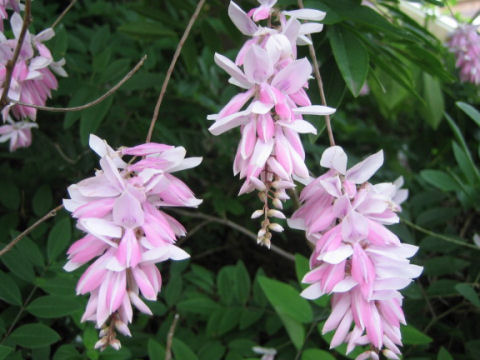
|


 とうあずき (唐小豆)
とうあずき (唐小豆)
|
|
 |


|

|
わが国の先島諸島から台湾、東南アジア、オーストラリア、アメリカのフロリダ州から熱帯アメリカ、熱帯アフリカに分布しています。蔓性で長さは10メートル以上になり、葉は羽状複葉で互生します。小葉は長楕円形で7~15対あります。夏と冬、長い花梗をだしてピンク色から紫色まれに白色の花を咲かせます。果実は莢果で、なかには朱赤色と黒色のツートンカラーの種子がつきます。葉にはサポニンが含まれ、天然甘味料として利用されます。一方、種子はネックレスなどの装飾用にもなりますが、猛毒のタンパク質アブリンが含まれ、誤って食べると腹痛や嘔吐を引き起こし、死に至ることもあります。台湾華語では、「雞母珠」。
|

|
マメ科トウアズキ属の常緑多年草で、学名は Abrus precatorius。英名は Rosary pea、Crab's eye, Coral pea。
|

|
The Rosary pea (Abrus precatorius) belongs to Fabaceae (the Pea family). It is an evergreen perennial herb that is distributed from the Sakishima Islands of Japan to Taiwan, Southeast Asia, Australia, and from Florida in the United States to tropical America and tropical Africa. It is vine, over 10 m long, and the leaves are pinnate compound that alternate. The leaflets are oblong and have 7 to 15 pairs. In summer and winter, it produces long peduncles and blooms pink to purple rarely white flowers. The fruits are pods with two-tone seeds of vermilion and black. The leaves contain saponin and are used as a natural sweetener. Seeds, on the other hand, can also be used for decoration such as necklaces, but they also contain the highly toxic protein abrin, which can cause abdominal pain and vomiting and even death if eaten by mistake. In Taiwanese Mandarin, "雞母珠".
|

|
オーストラリア・シドニー市チェリーブルックにて、2005年12月02日撮影。(photo by Yumi Gunji)
|
 |
|
|

|


